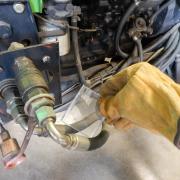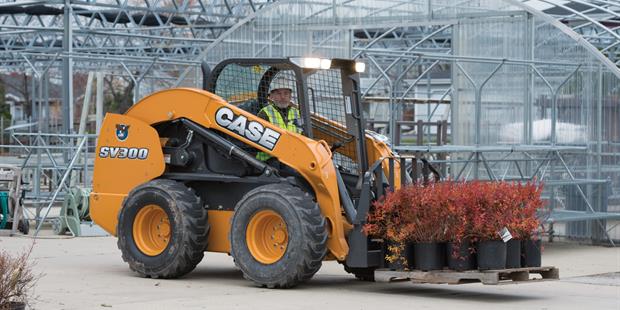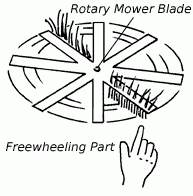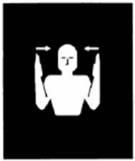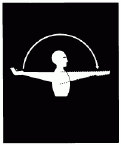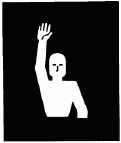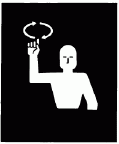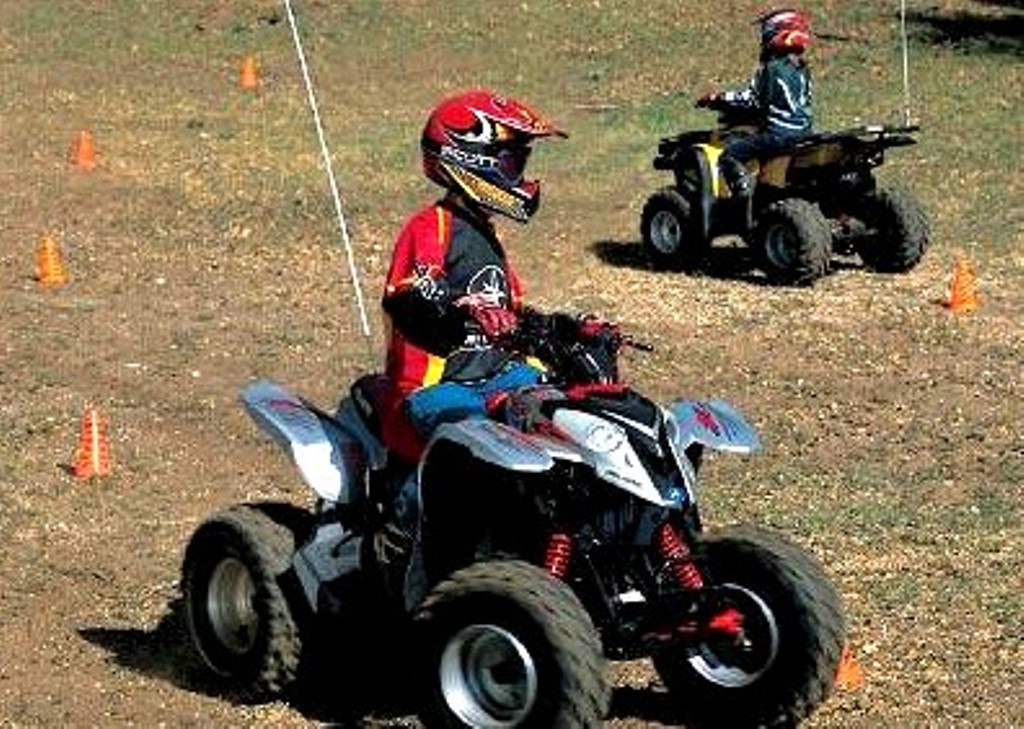Use the following format to cite this article:
Increasing the Visibility of Agricultural Equipment on Public Roadways. (2012) Farm and Ranch eXtension in Safety and Health (FReSH) Community of Practice. Retrieved from http://www.extension.org/pages/65225/increasing-the-visibility-of-agricu….
You must be extremely cautious when moving agricultural equipment on public roadways. Tractors and agricultural implements typically travel on roadways at speeds of less than 25 mph. Other motor vehicles travel at faster speeds, and many motorists do not realize the amount of braking time necessary to avoid rear-end collisions.
To reduce the risk of such collisions, state motor vehicle regulations require that agricultural equipment on public roadways be highly visible to motor vehicles approaching from behind. Your farm equipment should be visible to other motorists from the greatest possible distance so that they will have ample time to slow down.
To increase the visibility of your agricultural equipment, you can use slow moving vehicle (SMV) emblems, as well as marking accessories and fully functioning lighting. Although lighting and marking accessories are necessary anytime you have equipment on a public road, they are especially important 30 minutes before sundown or 30 minutes after sunrise. For added safety on narrow roads, you may consider having an escort vehicle drive in front of you. On winding roads, you may wish to have an escort drive behind you.
SMV Emblem

(Source: Pennsylvania State University. Agricultural Safety and Health)
An SMV emblem is a highly reflective sign that should be placed on the back of all tractors, towed implements, and self-propelled implements. It is an equilateral triangle at least 14 in. in height, made from a fluorescent orange material (which provides visibility during the day) and bordered by red retroreflective material (which provides visibility at night).
Laws concerning SMV emblems vary by state—most states require SMV emblems on all implements of husbandry (agricultural machinery) traveling at speeds of less than 25 mph. Farmers and ranchers are responsible for the proper use and maintenance of SMV emblems. Check the laws in your state for specific regulations.
The placement of an SMV emblem is critical to its effectiveness. Adhere to the following guidelines when affixing an SMV emblem:
- Place the emblem at the rear of the vehicle or implement, with the triangle pointing upwards.
- As much as possible, center the emblem horizontally on the vehicle.
- Make sure the bottom edge of the triangle is from 2 to 10 ft. above the ground.
An SMV emblem can become covered with dirt; over time, it can fade due to sun exposure. To maintain the best reflective properties, regularly clean and replace SMV emblems.
The only appropriate use of an SMV emblem is to increase the visibility of agricultural equipment traveling on public roadways. Do not use an SMV emblem for any other purpose (such as marking a driveway).
Speed Indicator Symbol
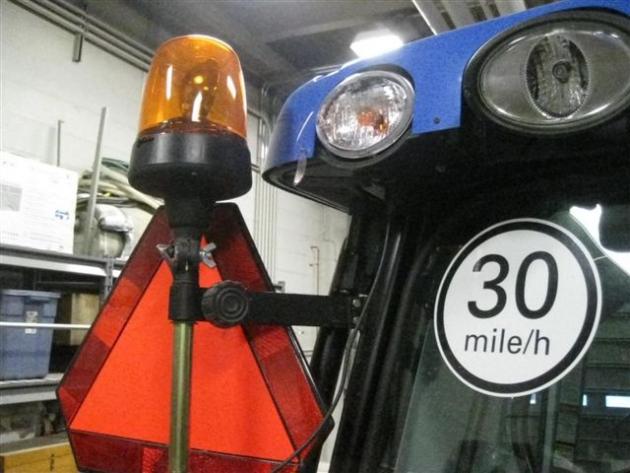
(Source: Pennsylvania State University. Agricultural Safety and Health)
Some tractors can travel faster than 25 mph. Mount a speed indicator symbol (SIS) on the rear of such tractors to indicate their maximum speed. Some states are now debating amending the SMV regulations to encompass faster tractors. Your state’s farm bureau can provide updates about such efforts.
Reflective Tape and Lighting
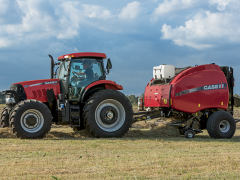
The American Society of Agricultural Engineers (ASAE) has developed guidelines and recommendations for lighting and marking farm equipment for roadway travel. The lists below summarize the most important recommendations for increasing the visibility of self-propelled and towed equipment.
Self-Propelled Equipment
- Headlamps and taillights: Equipment should have two headlamps and two taillights. At each end of the equipment, the lights should be mounted at the same height and spaced as far apart as possible on either side of the center line of the equipment.
- Work lamps: Equipment should have work lamps, but rear-facing work lamps should not be used while on roadways.
- Warning lights: Any vehicle or towed equipment with a width of 12 ft. or more should have flashing amber lights located on its sides. The lights should flash in unison at a rate of 60 to 85 flashes per minute.
- Turn indicators: Equipment should have turn indicators in addition to red taillights.
- 7-terminal receptacle: Any tractor or truck used for towing should be equipped with a 7-terminal receptacle to power lights on a trailing piece of equipment.
Towed Equipment
- Rear reflectors: The widest part of the rear extremities of the equipment should be outfitted with red reflectors to ensure visibility from up to 600 ft. behind the equipment.
- Front reflectors: The front left and right sides of the equipment should have yellow reflectors.
- Reflective and fluorescent (conspicuous) material: Equipment should be marked with a combination of reflective and fluorescent material. Yellow conspicuous material should be used in the front, and red-orange reflective material should be used to outline the back.
- SMV emblem: An ASAE-approved SMV emblem should be attached at the center, or slightly to the left of the center, of the back of the equipment.
Increasing the Visibility of Agricultural Equipment on Public Roadways. (2012) Farm and Ranch eXtension in Safety and Health (FReSH) Community of Practice. Retrieved from http://www.extension.org/pages/65225/increasing-the-visibility-of-agricu….
Sources
Agricultural equipment on public roads. (2009) Committee on Agricultural Safety and Health Research and Extension. Retrieved fromhttp://nasdonline.org/static_content/documents/2065/d001906.pdf.
Hallman, E. and Abend, E. (2005) Roadway safety: Lighting & marking of agricultural equipment. Cornell Cooperative Extension. Retrieved from http://nasdonline.org/1878/d001821/roadway-safety-lighting-and-marking-o….
Hanna, M., Schwab, C., and Miller, L. (2000) A new look for farm safety: Reflective and fluorescent tape. Iowa State University Extension and Outreach. Retrieved from https://store.extension.iastate.edu/ItemDetail.aspx?ProductID=758.
Legault, M. (2002) National farm safety and health week… Not just for farmers anymore part II. The National Education Center for Agricultural Safety. Retrieved from http://nasdonline.org/document/201/d000149/farm-safety-and-health-week-not-just-for.html.
Petrea, R. (n.d.) Forage harvesting safety. University of Illinois Extension. Retrieved from http://web.extension.illinois.edu/agsafety/factsheets/fhs.cfm.

